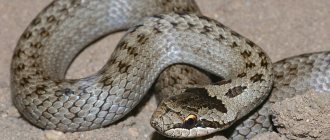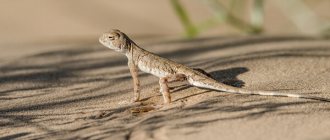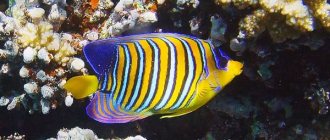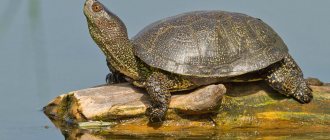The hero of this story about the Crimean fauna will be the yellow-bellied lizard. Have you heard of this? The yellowbell is a legless lizard that belongs to the order Squamate. The yellowbell belongs to the spindle family, genus - armored spindles.
The nature of Crimea is unique and inimitable. On this relatively small piece of earth, so many diverse “children” of Mother Nature live and grow! Everything is amazing here: flora, fauna, unusual landscapes, mysterious stories and beliefs of local residents, attracting tourists from all over the world. The animals of Crimea deserve special mention.
Tailless yellow-bellied lizard
What does a yellow-bellied lizard look like?
These reptiles are quite large in size. The body length of an adult yellowbell can reach 1.5 meters! The tail occupies most of the body. The animal has no neck at all; the head completely merges with the body. The muzzle has a narrowed shape at the end. The yellowbell is not a very flexible animal, because its entire body is covered with large scales that have a ribbed structure.
When the yellowtail grows, its skin turns brown and yellow, sometimes with spots, while young individuals have a more variegated color. The yellow-bellied belly is light-colored.
Zheltopuzik is a typical representative of the Crimean fauna.
Appearance
The lizard, masquerading as a dangerous snake, with the funny name yellow-bellied, can grow up to one and a half meters. An ordinary individual that can be found in Anapa reaches a size of 50-70 centimeters. The body does not have the legs typical of lizards; nature denied the yellow-bellied such luxury, leaving only small tubercles near the anus.
The body begins with a large tetrahedral muzzle with a pointed nose. The head has strong jaws with blunted teeth. The body, consisting of hard scales, is slightly compressed from the sides and ends with a long tail. The abdominal and dorsal regions, closing, form a fold that runs along the yellow-bellied body. The transition from the body to the tail is almost invisible. Due to the bone armor in which the string is encased, the body is elastic and dense; this structure prevents the lizard from twisting into rings like a snake.
The body color of an adult yellow belly has an olive or dark yellowish tint, the abdominal part is slightly lighter. The young are very different from their parents because of the black stripes that cover their entire body.
Lifestyle and behavior of the yellowbell in nature
This representative of the squamate order prefers open areas, so it can be found in semi-deserts, on mountain slopes, in the steppe, in vineyards and woodlands. The yellow belly also loves to live in fields. In mountainous areas it climbs to a height of 2300 meters above sea level.
A couple of yellowbellies living in a terrarium.
Active life activities take place during daylight hours. This animal does not really gravitate towards damp and hidden places from the sun; on the contrary, most often it crawls out into the sun and spends time basking in dry, open clearings. But if the day is too hot, the yellowbell may hide in a thicket of bushes or a pile of stones.
However, the yellowbell still requires water, but for this it uses shallow waters. Having climbed into the water, he can sit in it for a long time, despite the fact that he hardly knows how to swim.
The lack of flexibility of the body does not prevent this amphibian from crawling at an impressive speed. During the day, a yellow belly can crawl in different directions across an area with a radius of 200 meters.
Pets
But usually reptiles are kept not for the sake of reproduction, but to observe their life. Owners especially enjoy the feeding process. After all, you can give food to a yellow belly by hand. But do not forget that an untamed lizard will be afraid of you and throw liquid, odorous excrement at you. It will take some time for your pet to get used to it.
Prepare a flat, horizontal terrarium, the bottom of which is covered with sand interspersed with coarse gravel. Make shelters. After all, the yellow belly in nature hides from the heat and rain. It is necessary to install a lamp to maintain the optimal temperature. The terrarium should have a feeder and a drinker. In captivity, lizards eat the same things as in nature: insects, rodents, eggs and fruits. You can also give small pieces of meat or chicken. The main thing is to monitor your pet’s health and not give him anything that will make him feel bad.
Our nature is full of miracles. The legless yellow-bellied lizard, interesting facts about which you found in this article, is one of them. We wish you to meet it in nature to see for yourself what an interesting creature it is.
The largest snake in Europe, despite its gigantic size, amazes with its grace and speed of movement. Yellow-bellied Snake
not poisonous, but it cannot be said that meeting with it will be safe.
There has always been a special interest in reptiles - a large one amazes the imagination and arouses curiosity. About yellowbelly
They tell a lot of fables and rumors. Russian researchers studied the slender snake; the works of scientists reflect reliable information and observations.
What is included in the diet of yellow Crimean lizards?
Yellowbellies feed mainly on mollusks. They love snails very much. And on the “dining table” of this legless lizard there are insects (various beetles), mice, toads, lizards, snakes, small chicks and even bird eggs. The yellow belly does not disdain carrion.
The most important enemy of yellowbellies is cars.
In addition to animal food, the legless lizard also includes some plants in its “menu”. She loves to eat apricots, grapes and other fruit crops.
Reproduction process
Lizards always mate after hibernation, when they emerge from suspended animation. Typically, this period lasts from March to May. There are no gender differences in this species of reptile, so only specialists can determine the gender after conducting a series of studies. Because of this, it is extremely difficult to propagate yellowbellies at home.
Lizards always mate after hibernation, when they emerge from suspended animation.
In the first month of summer, the female lays eggs; on average, she can lay 6-10 eggs. The shape of the eggs is oval, the size is about 2 cm in transverse diameter, 4 cm in longitudinal diameter. The lizard usually immediately tries to hide them in the foliage, while carefully watching them and protecting them until the young emerge. This period lasts from 35 to 60 days.
The optimal temperature for embryo development is +30 °C. When born, the cubs are up to 12 cm long, excluding the tail. Puberty occurs in the fourth year of life. As a rule, by this time the individual has already grown to 0.5 m. The average life expectancy of yellowbellies in the natural environment reaches 30-35 years.
Security
As an endangered species, the yellowbell is listed in the Red Book of Ukraine and the Red Book of Kazakhstan. It is listed as endangered in the Red Book of the Krasnodar Territory. It is protected in the Aksu-Zhabagly Nature Reserve, in the Yalta Mountain Forest, Cape Martyan, Crimean and Kazantip nature reserves. Measures to preserve the species include relocating lizards from declining urban populations to nearby protected areas, strengthening the protection of the Karalar steppe, reintroducing the species into the Karadag and Opuk nature reserves, and outreach to the population.
It was the yellowbellies that portrayed snakes (of which the main character Indiana Jones is terrified) in Steven Spielberg's film Raiders of the Lost Ark. It is curious that the English name for lizards - sheltopusiks - is a slightly distorted version of the Russian word.
Will not offend a person
Strong jaws are excellent at catching and eating prey. However, for some reason the yellow belly cannot protect itself from human touch with their help. Therefore, a person can safely pick up this harmless creature and take a closer look. She won't bite. But he can make it so that you yourself release her into freedom. This animal sprays its enemy with feces that have a pungent odor. So the hand will open involuntarily. Some believe that the yellow-bellied lizard is poisonous. This is wrong. It kills its prey in a completely different way.
Where does the yellowbellied snake live?
Photo: Yellow-bellied snake
The yellow-bellied snake is found on the Balkan Peninsula, in parts of Eastern Europe to the Volga region and in a small part of Asia Minor. It can be found in the open steppe, in steppe and mountain forests, on the edges of steppe forests, in bushes near roads, in semi-deserts, in sand and on slopes, near mountain streams, between bushes covered with vegetation, stones and rocks, on the slopes of valleys and ravines , on steep banks along rivers and dry reeds.
In the North Caucasus, yellowbellies penetrate desert areas with sandy mounds. During dry periods of the year, it is often found near river beds and even in swamps. Often crawls in search of food and places to lay eggs in various ruins, including the ruins of houses, in household outbuildings or even in residential buildings, under haystacks, in gardens, vineyards and other similar places. In the mountains it rises to a height of 2000 m. In the Caucasus it is found at altitudes from 1500 to 1600 m.
Populations of the yellow-bellied snake have been recorded in the following countries:
- Albania;
- Bulgaria;
- Macedonia;
- Serbia;
- Turkey;
- Croatia;
- Greece;
- Romania;
- in the south of Slovakia;
- Moldova;
- Montenegro;
- on the south of Ukraine;
- In Kazakhstan;
- in the south of Russia;
- in the south of Hungary;
- Jordan.
Habitats may be distributed in lowlands near large rivers such as the Danube and the Olt River. Previously, it was assumed that the yellow-bellied snake became extinct in Moldova, eastern Romania and southern Ukraine, where only two habitats were known and the snake had not been observed since 1937. However, three specimens were collected in May 2007 in Galati County in Romania.
In Hungary, the Yellowbelly was previously thought to live in only two areas, but a recent survey of the region has revealed several previously unknown habitats of these snakes along the Danube River. In southern Crimea there is an average of 1 specimen per 2 km², in northern Dagestan - 3-4 snakes per km², and in southern Armenia - on average 1 specimen per 1 km².
Now you know where the yellow-bellied snake lives. Let's see what she eats.
Longest title
The longest title among the nobles who owned lands in Crimea was apparently held by Prince Grigory Alexandrovich Potemkin-Tavrichesky. His full title is as follows: His Serene Highness Prince Potemkin-Tauride, President of the State Military Collegium, Field Marshal General, Great Hetman of the Cossack, Ekaterinoslav and Black Sea troops, Commander-in-Chief of the Ekaterinoslav Army, regular light cavalry, Black Sea Fleet and other land and sea military forces; Senator, Ekaterinoslav, Tauride and Kharkov Governor-General; Her Imperial Majesty's troops Inspector General, Adjutant General, Acting Chamberlain, Life Guards Preobrazhensky Regiment Lieutenant Colonel, Corps of Cavalry Chief; Orders of Andrei Nevsky, St. George, Equal to the Apostles Prince Vladimir, St. Anne, Prussian Black Eagle, Danish Elephant, Swedish Seraphim, Polish White Eagle, St. Stanislaus Knight.











